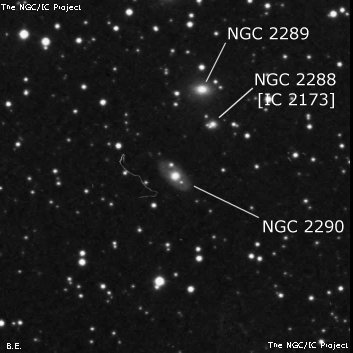
William Herschel discovered NGC 2290 = H III-898 = h410, along with NGC 2289, on 4 Feb 1793 (sweep 1031). His description reads, "Two, eF and vS. The place is taken between them. They are about 4' asunder and northern one which is the largest precedes the other about 2 sec. 300x shows the same." His RA is 15 sec too large, but the NPD is in between the pair. John Herschel observed the pair on 22 Jan 1827 (sweep 51) and measured reasonably accurate positions.
George Stoney independently found the entire quintet (NGC 2288, 2289, 2290, 2291, 2294) on 19 Apr 1849 and the group was accurately sketched. Dreyer credited LdR and d'Arrest (his single position is 10 seconds of time too large) with the discovery in the GC supplement (GCS 5369) as he was probably unsure of the identities of H III-897 and III-898. All positions in the GC and NGC are offset roughly 4' too far south and 8 seconds to time too far west. In the NGC, Dreyer incorrectly assigned III-897 to NGC 2290 or NGC 2291. Hermann Kobold measured accurate positions in 1898 at Strasbourg.
300/350mm - 13.1" (12/22/84): faint, small, elongated SW-NE, similar to NGC 2289 2.6' NNW.
400/500mm - 17.5" (12/19/87): third of five and brightest in the NGC 2289/NGC 2290 group. Fairly faint, fairly small, oval SW-NE, bright core. NGC 2289 lies 2.6' NNW and NGC 2288 1.8' NNW.
Notes by Steve Gottlieb